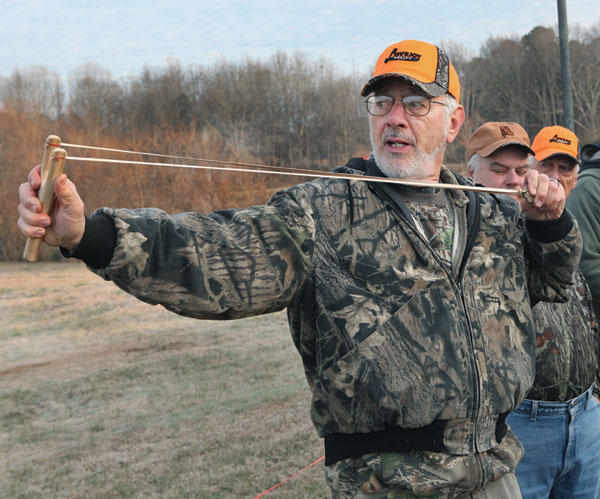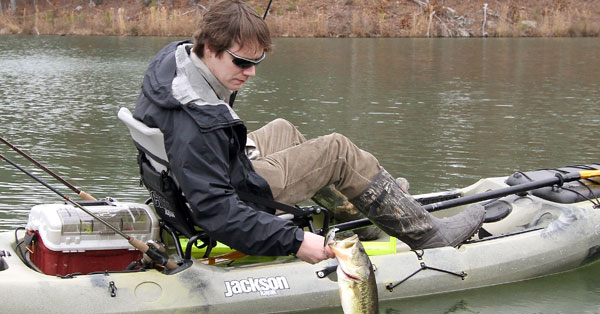Hobby becoming backyard business for Riverside beekeepers
 Story by Graham Hadley
Story by Graham Hadley
Photos by Michael Callahan
What started with 3 pounds of bees in a mail-order kit a few years ago has become a thriving backyard business for one Riverside couple.
Nick and Lori Thomas, the husband-and-wife beekeeping team, work together to harvest honey, tend to their ever-expanding bee population and manage the sale of honey, bees and wax — and all in their spare time.
Graduates of Jacksonville State University, they both have jobs at the Anniston Army Depot and are busy raising a family, too.
While they are not ready to quit their day jobs, the demand for their products is growing almost faster than they can keep up with it.
“We actually sold too much honey last year,” Nick said. “We did not have enough left over for ourselves,” continued Lori.
This year, honey production is much higher, though, both because they have more hives and because each one is more productive.
“We are as excited as our repeat customers are to see the increase in the honey this year,” Nick said.
It started with old stories
Holding up her baby son, Ethan, Lori says he will make the third generation of beekeepers in the family. “First your Papa (Nick’s grandfather), then Nick and, one day, this one.”
Nick is quick to point out that his grandfather, Wayne Hare, was not exactly a “beekeeper” in the truest sense of the word, but it was his stories that captured Nick’s imagination and drove his interest in bees.
“He was not a beekeeper. He would go with his uncle to rob bee trees of honey. He would tell me stories of how they did it, how they would find bees and follow them,” Nick said. They would cut out the beehives and take the honey home.
“He really sparked my interest with those stories,” Nick said.
After they were married, Nick would often toy with the idea of keeping bees as a hobby.
“He had talked and talked about it. So one Valentine’s Day five years ago, he got his first hive,” Lori said.
Three pounds of worker bees and one queen came in the package — a simple wood frame with screens on both sides.
The project was a success from the word “go.” The first year, the colony swarmed — the process by which one hive has grown and splits into two. Often the old queen will take half the workers and look for a new home.
Nick saw the swarm in the air and employed what he thought was a bit of a wives’ tale from his grandfather — he threw his baseball cap into the flying bees.
“I don’t know why it works, maybe they think they are being attacked by birds, but you throw the hat and they cluster — land all in one spot. My grandfather told me about it, and it worked,” Nick said.
They quickly gathered up the swarm.
“One turned into two; two into four, and so on,” he said.
Currently, Nick and Lori have around 15 colonies of bees. They have had as many as 21 colonies, but they sell off the extra colonies to other beekeepers.
“One guy drove all the way up north with the bees in his car — he called to let us know he had arrived with no trouble,” Nick said.
Several years after that first batch arrived, Nick’s hobby is starting to make money for them and help pay for itself. They made a little profit last year and, with this year’s windfall of honey, they are expecting a much larger profit — unless they buy more equipment or expand their operation, Lori said.
“There are a lot of startup expenses. Bees are not cheap, especially professional honey-extraction equipment,” Nick said.
Handle with care
Not only are bees not inexpensive, they require special care and handling, both to make sure the bees thrive and to avoid stings — something that is not entirely possible for beekeepers (or magazine writers, apparently).
The Thomas’ operation produces honey, beeswax — which they sell in bars and as candles — and bee colonies called nucleus hives. So far this year, they have harvested 480 pounds (more than 40 gallons) of honey. That is a huge increase over last year’s 120 pounds.
And, though they can’t be certified organic because Nick and Lori have no way to control where the bees gather their nectar, they do manage their entire operation without harmful chemicals or artificial additives. Instead, they find natural ways to control pests, like using cinnamon to remove parasites.
Likewise, the Thomases double filter their honey but don’t pasteurize it like big commercial distributors do, a process which both of them say destroys many of the beneficial and homeopathic properties of the honey. They also say it is not necessary. Honey is, by its very nature, mostly sterile and has a near-infinite shelf life.
“People say our honey tastes better than the big commercial brands, which are so over filtered, over pasteurized, over processed,” Lori said.
Even their wax is just that, beeswax — no additives or scents. “It just smells like honey,” she said.
What Nick says he enjoys most are caring for the bees and making sure the colonies are healthy and watching for swarming, which is important to prevent because you not only lose bees, they eat lots of honey before leaving. He also enjoys harvesting the honey, but says that can be a lot of work, often requiring long stretches in a hot bee-suit.
Before approaching the hives stacked across the back of their property, Nick and Lori suit up in outfits that cover them head to toe, with screens around their head so they can see out, but the bees can’t get in.
Nick says stings happen, but not nearly as often as you would expect from someone who handles thousands of bees every day. Part of that is because Nick and Lori keep Italian bees, which are more docile than other breeds.
Carrying a smoker — a can with burning leaves or grass — they approach the hives, opening the sections where the bees build combs to store honey, not the areas where the bees actually build cells for breeding. Then, they remove the racks.
Each rack contains honeycomb covered in wax caps, every cell full of honey. They gently remove the bees and store the racks in a case to carry back to the garage where their equipment is kept. The whole process takes only a few minutes.
Once back in the garage, Nick or Lori quickly closes the garage door — if they did not, the bees would follow the honey inside.
“One time, I had been working in here and had left the door open after draining most of the honey out of the extractor — there was maybe an inch in the bottom. I came back down and the garage was full of bees. They were everywhere,” Nick said.
“I learned then what to do when your garage is full of bees. I left the top off the extractor and closed the garage door. The bees all went in and ate the honey left in the bottom. Once they got their fill, I opened the door and they all flew directly back to the hive. They were all gone.”
After hanging up their suits, Nick and Lori set up kind of an assembly line, with Lori removing the racks from the case and giving them to Nick, who uses a special tool to quickly scrape the caps off the honey comb, exposing the honey.
He places the racks in an extractor, a large steel centrifuge that literally spins the honey out of the racks. From there, it is poured out of a spout through the filters and into a container to be bottled.
And, though they will sell jars with the wax comb in them by special order, generally the combs stay in the racks, which are taken back out to the hives to be refilled by the bees.
It takes a lot of work and energy for the bees to rebuild the combs if they are removed, so leaving them in means more productive hives and healthier bees. And Lori and Nick both point out that, like any other animal they keep, the health of their bees is important to them.
The honey is bottled and sold, either in small parcels or in bulk, to their customers. The wax caps are melted in a double boiler and poured into molds, made into candles or just as bars of wax, and sold.
So far, they sell out to their customers and don’t have enough to put in stores, but Nick says they would like one day to have their products sold off of shelves next to other brands.
“Right now, many of our customers buy in bulk. We have one lady who bakes with it, so she buys a lot,” Nick said.
Beyond their backyard
Admittedly, Nick and Lori have almost the ideal location for beekeeping — they originally bought enough land for their horses — and have taken time to learn about the process, using that knowledge to continually improve their techniques.
Lori said one thing they had to do was dig a pond on the property. They have a fountain out in front of the house, and bees, like everything else, need water. The fountain became their favorite source.
“It was like a bee highway between the hives and the fountain. Every time you would walk out there, you were getting bumped by bees going back and forth.” It was time for Nick to dig a pond in the back, she said.
In addition to their land and the pond, Nick says they are surrounded by about a hundred acres of diverse woodland, which is the perfect environment for the bees to forage in.
Lori has a degree in chemistry, which comes in handy with the business, and Nick is continually working to broaden his knowledge — and they both want to share their knowledge and experience with others.
About a year ago, Nick and Lori formed the St. Clair County Beekeepers Association, a new organization for the county. An affiliate of the Alabama Beekeepers Association, they meet with other beekeepers from around the area to share their knowledge and experience.
And that process is a two-way street. Nick, who is the president of the association, prepares presentations for the meetings, often expanding his own information resources in the process. In return, they learn additional trade secrets from veteran beekeepers.
And, like their beekeeping operation, the association has been a success. In operation since last August, the St. Clair Beekeepers Association now boasts around 30 members.
Nick and Lori also raise and show exotic animals — everything from snakes to African pygmy hedgehogs. To learn more about the Thomas’ operation, visit their website, www.thomas-farm.com. To learn more about the St. Clair County Beekeepers Association, www.sccba.net.
Editor’s note: Michael Callahan gets a special nod for shooting these photos without a bee suit or netting.



















































































































